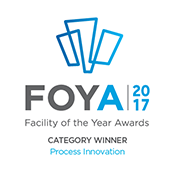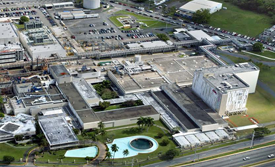
Eli Lilly and Company
Location: Indianapolis, Indiana, USA and Carolina, Puerto Rico
Project: Continuous Direct Compression Manufacturing Kits 2 & 3
The Process Innovation  award recognizes the application of novel process manufacturing techniques on existing and new facilities that drive forward thinking and innovative applications in processing, manufacturing and scientific approaches to drive solutions to existing or new challenges in the industry. Eli Lilly and Company won the Process Innovation category for their implementation of Continuous Direct Compression (CDC) Process and other process innovations in their Oral Solid Dose (OSD) Facilities across their manufacturing network.
award recognizes the application of novel process manufacturing techniques on existing and new facilities that drive forward thinking and innovative applications in processing, manufacturing and scientific approaches to drive solutions to existing or new challenges in the industry. Eli Lilly and Company won the Process Innovation category for their implementation of Continuous Direct Compression (CDC) Process and other process innovations in their Oral Solid Dose (OSD) Facilities across their manufacturing network.
Lilly’s implementation of a continuous OSD manufacturing network offer forward thinking elements:
- CDC is the default platform for OSD at Lilly
- Simple and compact design
- Effective implementation and application of near-infrared (NIR) integrated with real-time residence time distribution (RTD) model
- Elimination of any high-shear mixing, roller compaction equipment, and powder diversion equipment between the mixer and the tablet press
- A progressive control scheme anchored by advanced automation and PAT (process analytical technology)
- Real-time rejection of any special cause upsets/variations with the use of spectroscopic PAT combined with automation logic
- The inclusion of soft sensors to estimate CQAs using process parameters
- The enabling of linkages to be made to external data systems such as laboratory information management systems (LIMS), raw material properties databases, and product development databases
- Advanced feeder control logic with feeder vibration engineered out
Additionally, Lilly’s CDC facilities considered during their process design a simple process implementation. The primary equipment consists of a small vertical envelope with feeders and a tablet press for which the system benefits from reduced complexity, faster startup times, easier maintenance, and improved ergonomics for operations personnel. The CDC installations were designed proactively thinking in the wide variety of future pipeline molecule demands, not just a single product. The feeder installation locations are modular and allow rapid reconfiguration of the system without requiring significant requalification. In deeper details, a single near- infrared (NIR) PAT instrument is positioned in the feed frame of the tablet press and is integrated with an online analytical model that allows for real-time tablet concentration measurements. Loss-in-weight feeder data is used to calculate the dispensed drug-substance concentration provided by the feeders. The feeder data is also used as the input to a real-time residence time distribution (RTD) model that predicts the expected drug substance concentration in the tablet press after accounting for system back-mixing. Lilly’s streamlined configuration is unusual in the industry due to the absence of any high-shear mixing, roller compaction equipment, and powder diversion equipment between the mixer and the tablet press. With fewer unit operations in the process flow, the system benefits from faster startup times, elimination of potential locations for unintended material accumulation, reduced potential for segregation after the feeders, and improved ergonomics for operations personnel. A safety benefit that accompanies the removal of any high-shear mixing equipment is avoiding the need for nitrogen inerting in any of the mixing zones to avoid unacceptable risk of combustible dust ignition.
 Lilly engineered an advance control scheme to drive high quality of their products. A progressive control scheme anchored by advanced automation and PAT (process analytical technology) are keys to assuring consistent control, low process variability, and higher quality assurance. Lilly’s process to monitor and control the mass balance is innovative because the feeders are actively controlled as a single system, through the use of a cascade control loop, rather than as a series of independent unit operations. At the system level, unit operations of feeding, mixing, and tablet compression are seamlessly integrated with online PAT and first principles modeling to provide a comprehensive unified control strategy. By designating a master feeder (typically the drug substance feeder) and modulating the other feeders in response to variation in the master feeder output, the concentration of the formulation components is maintained more consistently. The powder feeder feedback control loops automatically adjust for raw material changes such as density and powder flowability. Lilly’s integrated design also reduces concentration variation associated with common-cause variability in powder mass flow from the master feeder.
Lilly engineered an advance control scheme to drive high quality of their products. A progressive control scheme anchored by advanced automation and PAT (process analytical technology) are keys to assuring consistent control, low process variability, and higher quality assurance. Lilly’s process to monitor and control the mass balance is innovative because the feeders are actively controlled as a single system, through the use of a cascade control loop, rather than as a series of independent unit operations. At the system level, unit operations of feeding, mixing, and tablet compression are seamlessly integrated with online PAT and first principles modeling to provide a comprehensive unified control strategy. By designating a master feeder (typically the drug substance feeder) and modulating the other feeders in response to variation in the master feeder output, the concentration of the formulation components is maintained more consistently. The powder feeder feedback control loops automatically adjust for raw material changes such as density and powder flowability. Lilly’s integrated design also reduces concentration variation associated with common-cause variability in powder mass flow from the master feeder.
In the case of real-time release, the facilities and process both leverage either online testing of traditional offline tests, or reduced testing due to high process capability and control. Real-time rejection of any special cause upsets/variations is accomplished through the use of spectroscopic
PAT combined with automation logic to reject any portions of the batch suspected of being out of limits. Real-time release or rejection is supported by immediate process residence time distribution (RTD) modeling or spectroscopic measurement of the powder. Following the mixers, a real-time RTD model is capable of combining the inputs from the feeders in combination with measured accumulation in the mixer and tablet press to predict concentration of the powder at the tablet press die a few minutes in the future.
Lilly expands the definition of PAT from spectroscopy to include soft sensors to estimate CQAs using process parameters (a “soft sensor” is a multivariate combination of inputs, often with a first-principle model, to estimate a parameter which would be difficult to measure directly). The soft sensor approach has the advantage of being easier and cheaper to maintain over a product’s lifecycle than spectroscopic methods and their specialized equipment.
A critical facility requirement to execute this automated control strategy is controlling vibration. The Lilly design engineered vibration out of the system. The feeder bases were designed to be rigid and isolated from vibration in the facility.
Advanced data analytics is an additional benefit of Lilly’s automation. Several automation tags were generated solely for the purpose of enabling linkages to be made to external data systems such as laboratory information management systems (LIMS), raw material properties databases, and product development databases. This enables rapid data analysis which facilitates both uninterrupted evaluation of critical quality attributes (CQAs) as well as continuous improvement to occur at a speed much faster than with traditional batch processes or if the connections between systems was accomplished manually and reviewed batch-wise (as has been the traditional methodology).
Lilly has leveraged the continuous manufacturing journey and found innovative ways to bring Continuous Direct Compression process to the next level.
Key Participants:
- Engineer/Architect: Mussett Nicholas & Associates
- Engineer/Architect: TLF Engineering; Babilonia Engineering Group
- Construction Manager: Davis & Associates; Fluor Daniel Caribbean, Inc.
- Main/General Contractor: Davis & Associates; Alproem Engineering Contractors
- HVAC/Piping Subcontractor: Davis & Associates; Alproem Engineering Contractors
- Automation and Control: Cornerstone Controls; Emerson Process Management; Prozess Technologie
- Major Equipment Suppliers/Contractors: Korsch America; Bruker Optics, Inc; CDM, Coperion Ktron; Gericke